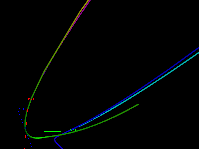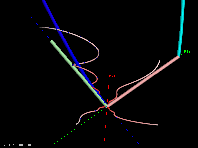
The phase space of the system conteins two fixed points:
F0, which is independent from the system parameters, located at (0/0/0/0), and F1 with the parameter dependent coordinates [vGSo]
pi1=-(m-1)(m-4)(e^2*m^2-4e^2*m+4+4e^2)/36(m-2)^2
pi2=(m-1)^2(e^2*m^2-4e^2*m+4+4e^2)/36(m-2)^2
pi3=(m-1)^2(m-4)(e^2*m^2-4e^2*m+4+4e^2)/108(m-2)^3
pi4=e(m-1)^2(m-4)(e^2*m^2-4e^2*m+4+4e^2)/216(m-2)^2
| By increasing the m parameter from -inf on, F1 moves along a curve in 4D, first approaching the origin and F0 along the negative pi2 axis, passing through F0 and moving in the direction of the instable equilibrium escaping into infinity at a parameter value of m=2.0. By further increasing m F1 appears again approaching F0 very fast close to the stable equilibrium, passing close to the origin and escaping again with m going against infinity. The picture shows the path of F1 for m=-40 to almost 1.9 (green tube) and from 2 to 10 (blue tube) as a projection normal to pi1, pi2 and pi4. pi3 is entirely dropped out. The violett tube represents the instable equilibrium, the light-blue the stable one. |  |
| The eigenvalue calculation for F0 reveals two conjugated complex eigenvalues corresponding to a rotational evolution around the fixed point and two real ones, corresponding to attracting or repelling characteristic directions. Due to the invariance of F0 to parameter changes the characteristic directions are constant throughout the parameterspace: (1/0/0/0) and (0/1/0/0). The image shows the characteristic directions as tubes with some nearby trajectories to demonstrate the evolution of states close to F0 at a m =-3. In addtion the relative equilibria are rendered as tubes. Time is coded into the saturation of the streamline color. |  |
In addition to the fixed points there are two relative equilibria, one stable and one instable (See [vGSo] for the explicit representations). Like F0, the equilibria are invariant to system parameter changes. System states on the equilibria move along them, never leaving the curves. The stable, repelling equilibrium intersects the pi2 axis at (0/0.25/0/0) and is defined for pi1>0. The instable, attracting equilibrium runs into F0 along the positive pi1 axis, tanging the (1/0/0/0) characteristic direction.
The properties of both fixpoints change wich changing values of m.The resulting changes in the system's behaviour will be discussed in detail in the following sections.